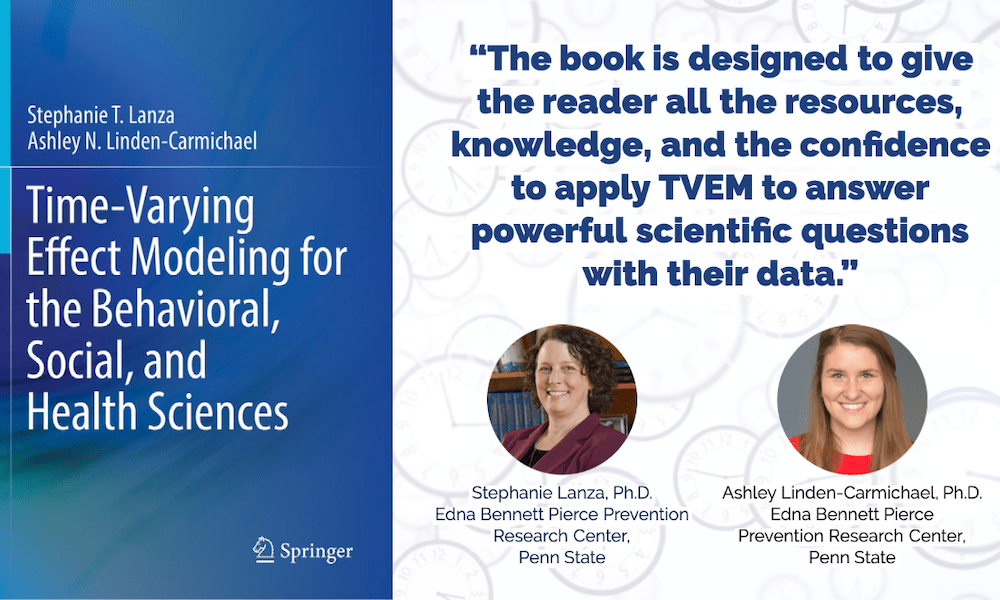New book: Time-Varying Effect Modeling for the Behavioral, Social and Health Sciences

TVEM-book-by-STL-and-ANL-C
June 4, 2021
This book, co-authored by Stephanie Lanza, Penn State professor of biobehavioral health and director of the Edna Bennett Pierce Prevention Research Center (PRC); and Ashley Linden-Carmichael, PRC assistant research professor, is the first to introduce applied behavioral, social, and health sciences researchers to a new analytic method, the time-varying effect model (TVEM). It details how TVEM may be used to advance research on developmental and dynamic processes by examining how associations between variables change across time.
“This book is designed to give the reader all the resources, knowledge, and the confidence to apply TVEM to answer powerful scientific questions with their data,” said Lanza.
The book describes how TVEM is a direct and intuitive extension of standard linear regression; whereas standard linear regression coefficients are static estimates that do not change with time, TVEM coefficients are allowed to change as continuous functions of real time, including developmental age, historical time, time of day, days since an event, and so forth.
“TVEM is unique in that you can creatively conceptualize time in a lot of different ways depending on your data set,” explained Ashley Linden-Carmichael. “For example, you can look at changes as a person matures, or you can look at changes within a day or across days.” She noted that TVEM lends itself well to daily diary studies, intensive longitudinal studies, and ecological momentary assessment studies, among other approaches.
“Applied researchers use regression every day, and TVEM is a simple way to open the door to answer a huge variety of new research questions,” added Lanza.
Readers gain the practical skills necessary for specifying a wide variety of time-varying effect models, including those with continuous, binary, and count outcomes.
“You can take this tool and really bring it into your own work and do something with it, whether it’s immediately conducting new analyses of existing data for a manuscript or writing a grant proposal to address novel scientific questions by applying these techniques,” Lanza said.
The book presents technical details of TVEM estimation and three novel empirical studies focused on developmental questions using TVEM to estimate age-varying effects, historical shifts in behavior and attitudes, and real-time changes across days relative to an event. The volume provides a walkthrough of the process for conducting each of these studies, presenting decisions that were made and offering sufficient detail so that readers may embark on similar studies in their own research.
The book concludes with comments about additional uses of TVEM in applied research as well as software considerations and future directions. Throughout the book, proper interpretation of the output provided by TVEM is emphasized.
TVEM Book Companion Website
Using the book’s companion website, readers can view all of the figures in the book, along with the mathematical equation and corresponding SAS code used to program each figure. “It allows the reader to know exactly what we’re testing,” said Linden-Carmichael. They can also use a convenient “copy to clipboard” feature to copy the syntax directly into their manuscripts or proposal documents, modifying the syntax as needed.
Time-Varying Effect Modeling for the Behavioral, Social and Health Sciences is an essential resource for researchers, clinicians/practitioners as well as graduate students in developmental psychology, public health, statistics and methodology for the social, behavioral, developmental, and public health sciences.
“The goal of the book and companion website is to facilitate researchers all over the world to pick up the technique and do it themselves,” said Lanza. “The potential is high and the barriers to using TVEM are low.”
About the Authors:
Stephanie T. Lanza, Ph.D., is the C. Eugene Bennett Chair in Prevention Research, Director of the Edna Bennett Pierce Prevention Research Center and Professor of Biobehavioral Health and Human Development. She works primarily in two methodological areas. Much of her work seeks to advance finite mixture models, particularly latent class analysis. She also works to advance and apply new statistical models in order to reveal dynamic processes, focusing on time-varying effect modeling to address new research questions related to health behaviors. For more information about Dr. Lanza, visit https://aimlab.psu.edu/people/stephanie-lanza/
Ashley N. Linden-Carmichael, Ph.D., is an Assistant Research Professor in the College of Health and Human Development and the Edna Bennett Pierce Prevention Research Center. Her program of research focuses on identifying influential and underlying psychosocial predictors and consequences of high-risk drinking behavior and substance co-use. Ashley has a particular interest in using innovative methods, such as daily diary designs, ecological momentary assessment, and wearable alcohol sensors to assess problematic alcohol use patterns in real-time. For more information about Dr. Linden-Carmichael, visit https://aimlab.psu.edu/people/ashley-linden-carmichael/
New book: Time-Varying Effect Modeling for the Behavioral, Social and Health Sciences

TVEM-book-by-STL-and-ANL-C
June 4, 2021
This book, co-authored by Stephanie Lanza, Penn State professor of biobehavioral health and director of the Edna Bennett Pierce Prevention Research Center (PRC); and Ashley Linden-Carmichael, PRC assistant research professor, is the first to introduce applied behavioral, social, and health sciences researchers to a new analytic method, the time-varying effect model (TVEM). It details how TVEM may be used to advance research on developmental and dynamic processes by examining how associations between variables change across time.
“This book is designed to give the reader all the resources, knowledge, and the confidence to apply TVEM to answer powerful scientific questions with their data,” said Lanza.
The book describes how TVEM is a direct and intuitive extension of standard linear regression; whereas standard linear regression coefficients are static estimates that do not change with time, TVEM coefficients are allowed to change as continuous functions of real time, including developmental age, historical time, time of day, days since an event, and so forth.
“TVEM is unique in that you can creatively conceptualize time in a lot of different ways depending on your data set,” explained Ashley Linden-Carmichael. “For example, you can look at changes as a person matures, or you can look at changes within a day or across days.” She noted that TVEM lends itself well to daily diary studies, intensive longitudinal studies, and ecological momentary assessment studies, among other approaches.
“Applied researchers use regression every day, and TVEM is a simple way to open the door to answer a huge variety of new research questions,” added Lanza.
Readers gain the practical skills necessary for specifying a wide variety of time-varying effect models, including those with continuous, binary, and count outcomes.
“You can take this tool and really bring it into your own work and do something with it, whether it’s immediately conducting new analyses of existing data for a manuscript or writing a grant proposal to address novel scientific questions by applying these techniques,” Lanza said.
The book presents technical details of TVEM estimation and three novel empirical studies focused on developmental questions using TVEM to estimate age-varying effects, historical shifts in behavior and attitudes, and real-time changes across days relative to an event. The volume provides a walkthrough of the process for conducting each of these studies, presenting decisions that were made and offering sufficient detail so that readers may embark on similar studies in their own research.
The book concludes with comments about additional uses of TVEM in applied research as well as software considerations and future directions. Throughout the book, proper interpretation of the output provided by TVEM is emphasized.
TVEM Book Companion Website
Using the book’s companion website, readers can view all of the figures in the book, along with the mathematical equation and corresponding SAS code used to program each figure. “It allows the reader to know exactly what we’re testing,” said Linden-Carmichael. They can also use a convenient “copy to clipboard” feature to copy the syntax directly into their manuscripts or proposal documents, modifying the syntax as needed.
Time-Varying Effect Modeling for the Behavioral, Social and Health Sciences is an essential resource for researchers, clinicians/practitioners as well as graduate students in developmental psychology, public health, statistics and methodology for the social, behavioral, developmental, and public health sciences.
“The goal of the book and companion website is to facilitate researchers all over the world to pick up the technique and do it themselves,” said Lanza. “The potential is high and the barriers to using TVEM are low.”
About the Authors:
Stephanie T. Lanza, Ph.D., is the C. Eugene Bennett Chair in Prevention Research, Director of the Edna Bennett Pierce Prevention Research Center and Professor of Biobehavioral Health and Human Development. She works primarily in two methodological areas. Much of her work seeks to advance finite mixture models, particularly latent class analysis. She also works to advance and apply new statistical models in order to reveal dynamic processes, focusing on time-varying effect modeling to address new research questions related to health behaviors. For more information about Dr. Lanza, visit https://aimlab.psu.edu/people/stephanie-lanza/
Ashley N. Linden-Carmichael, Ph.D., is an Assistant Research Professor in the College of Health and Human Development and the Edna Bennett Pierce Prevention Research Center. Her program of research focuses on identifying influential and underlying psychosocial predictors and consequences of high-risk drinking behavior and substance co-use. Ashley has a particular interest in using innovative methods, such as daily diary designs, ecological momentary assessment, and wearable alcohol sensors to assess problematic alcohol use patterns in real-time. For more information about Dr. Linden-Carmichael, visit https://aimlab.psu.edu/people/ashley-linden-carmichael/








